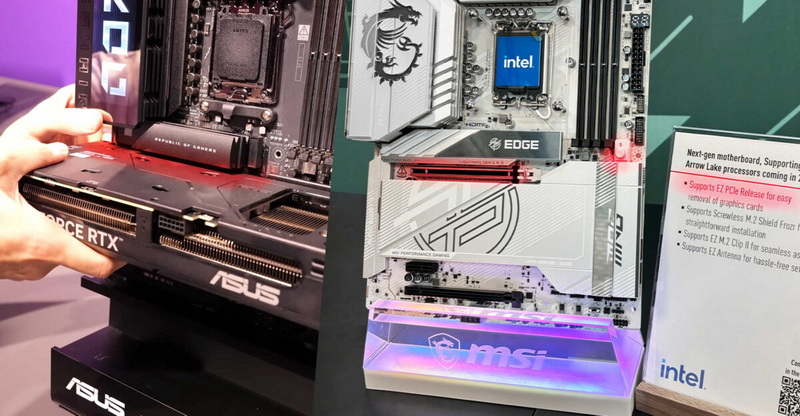Removing a graphics card from a PCIe slot on a motherboard can be a challenging task. Especially if we are talking about a massive video card with two, three or more expansion slots thick. Fortunately, motherboard manufacturers do not stand still and with each new generation of hardware they try to make life easier for PC owners. Another improvement is coming in new boards for Intel and AMD chips.

Image source: VideoCardz
With the advent of massive video cards from Nvidia and AMD, flagship motherboards began to be equipped with a special mechanism that simplifies the removal of the graphics accelerator. It includes a special button, located, as a rule, on the right side of the motherboard, next to the chipset heatsink. When pressed, the button pulls on a cable attached to the PCIe x16 slot latch, which moves back and allows you to release the video card from the connector.
In the new generation of motherboards based on AMD 800 series chipsets from Asus, this mechanism has been improved. It’s called PCIe Q-Release Slim GPU, it no longer uses a button, and the PCIe slot itself has changed. The tension mechanism is now built directly into the connector. The PCIe slot latch will not release the video card if the latter is pulled from the slot from the center or from the right side of the GPU. However, the card is easily released from the slot if you pull it from the left side (from the rear panel of the motherboard connectors). This greatly simplifies the removal of the video card. The operation of the new mechanism for installing/removing a video card was demonstrated by enthusiast Roman “Der8auer” Hartung, who visited the Asus stand at the Gamescom gaming exhibition.
MSI also showed a new mechanism for installing/removing a video card, called EZ PCIe Release. It will be equipped with older models of motherboards based on Intel 800 series chipsets for Arrow Lake-S processors. True, in their case the mechanism includes a button. The button mechanism itself received an indicator indicating whether the slot for removing the card is open or not. The operation of the mechanism was demonstrated on the Z890 MPG EDGE motherboard.
It is highly likely that other motherboard manufacturers will also follow the example of their counterparts from Asus and MSI. Similar mechanisms that simplify the removal of video cards were found on the new Gigabyte Aorus, Biostar Valkyrie and ASRock Taichi boards, which were shown at Computex 2024.
It is obvious that the PCI Express interface will not disappear anywhere in the near future and will remain the main means of connecting video cards to a PC. It’s good to see that manufacturers continue to look for better solutions to such an obvious problem with this interface in the age of huge graphics accelerators. Many companies are also continuing to simplify the process of installing NVMe drives into M.2 slots by eliminating the use of screw mounts, which also simplifies PC assembly.